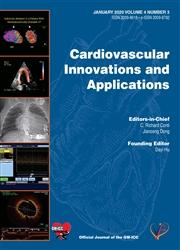Correlation between the Hemoglobin, Albumin, Lymphocyte, and Platelet (HALP) Score and Left Ventricular Hypertrophy in Older Patients with Hypertension*
IF 1.4
4区 医学
Q4 CARDIAC & CARDIOVASCULAR SYSTEMS
引用次数: 0
Abstract
Introduction: Hypertension and left ventricular hypertrophy (LVH) have emerged as significant risk factors for cardiovascular events and all-cause mortality. Inflammation and nutrition play critical roles in the development of hypertension and damage to target organs. The HALP Score, which assesses levels of hemoglobin, albumin, lymphocytes, and platelets, is an index closely associated with inflammation and nutrition, and has been demonstrated to be particularly effective in the older population. Hence, the objective of this study was to examine the correlation between the HALP Score and LVH in older patients with hypertension. Methods: We collected and retrospectively analyzed data from 234 older patients, including clinical data, and routine blood, liver function, kidney function, and cardiac ultrasound parameters. All patients were categorized into a non-left ventricular hypertrophy (NLVH) group (n = 131) or an LVH group (n = 103). The association between the HALP Score and LVH was investigated, and potential influencing factors were considered. Results: The LVH group had a significantly lower HALP Score than the NLVH group. Logistic regression analysis revealed that a lower HALP Score and female sex were independent factors associated with LVH in older patients with hypertension (OR = 0.944, 9.962, 95% CI: 0.910–0.979, 3.866–24.300, P = 0.002, <0.001). The area under the curve for the HALP Score in diagnosing LVH in older patients with hypertension was 0.708 (95% CI: 0.641–0.776, P = 0.002). Conclusion: The HALP Score is significantly associated with LVH in older patients with hypertension: lower scores indicate a greater likelihood of LVH. The HALP Score has moderate diagnostic value for LVH in this population.老年高血压患者血红蛋白、白蛋白、淋巴细胞和血小板(HALP)评分与左心室肥厚的相关性*
高血压和左心室肥厚(LVH)已成为心血管事件和全因死亡率的重要危险因素。炎症和营养在高血压的发展和靶器官的损害中起关键作用。HALP评分评估血红蛋白、白蛋白、淋巴细胞和血小板的水平,是一个与炎症和营养密切相关的指标,已被证明对老年人特别有效。因此,本研究的目的是探讨老年高血压患者HALP评分与LVH的相关性。方法:回顾性分析234例老年患者的临床资料、血常规、肝功能、肾功能及心脏超声参数。所有患者被分为非左室肥厚组(n = 131)和左室肥厚组(n = 103)。研究HALP评分与LVH的相关性,并考虑可能的影响因素。结果:LVH组HALP评分明显低于非LVH组。Logistic回归分析显示,较低的HALP评分和女性是老年高血压患者LVH的独立影响因素(OR = 0.944, 9.962, 95% CI: 0.910-0.979, 3.866-24.300, P = 0.002, <0.001)。HALP评分诊断老年高血压患者LVH的曲线下面积为0.708 (95% CI: 0.641-0.776, P = 0.002)。结论:老年高血压患者的HALP评分与LVH有显著相关性,评分越低,LVH发生的可能性越大。HALP评分对LVH的诊断价值中等。
本文章由计算机程序翻译,如有差异,请以英文原文为准。
求助全文
约1分钟内获得全文
求助全文
来源期刊

Cardiovascular Innovations and Applications
CARDIAC & CARDIOVASCULAR SYSTEMS-
CiteScore
0.80
自引率
20.00%
发文量
222
 求助内容:
求助内容: 应助结果提醒方式:
应助结果提醒方式:


